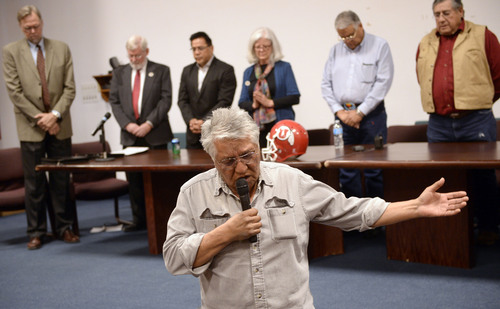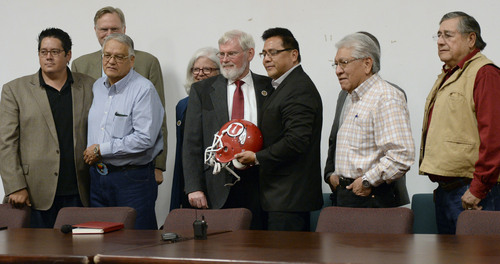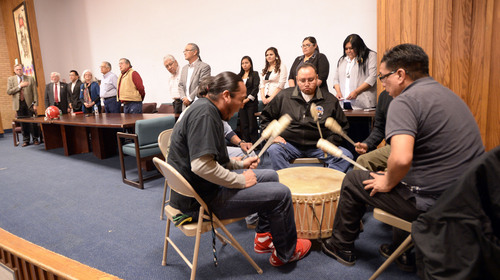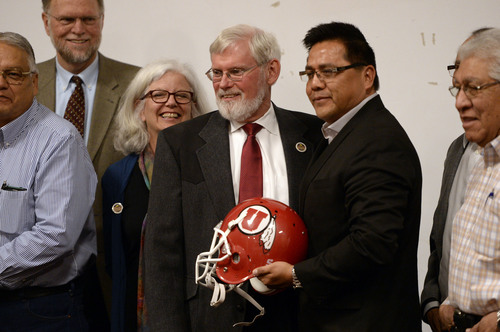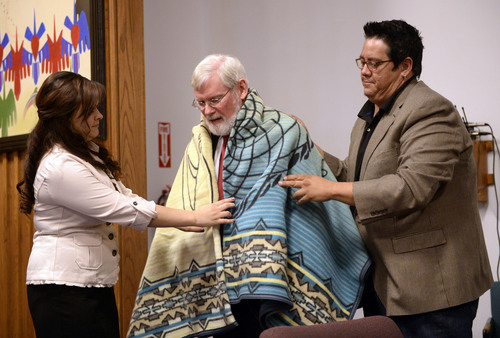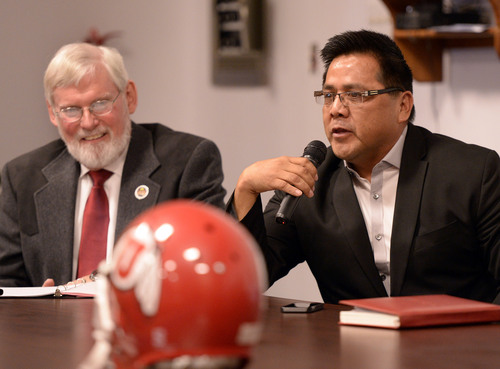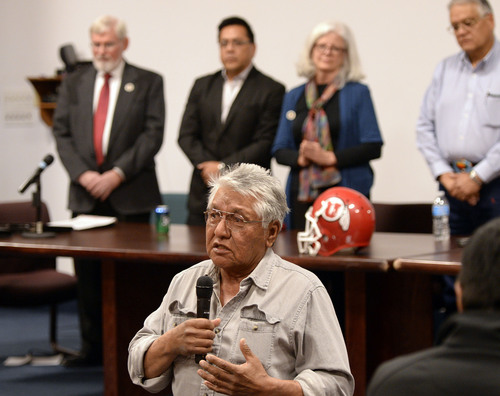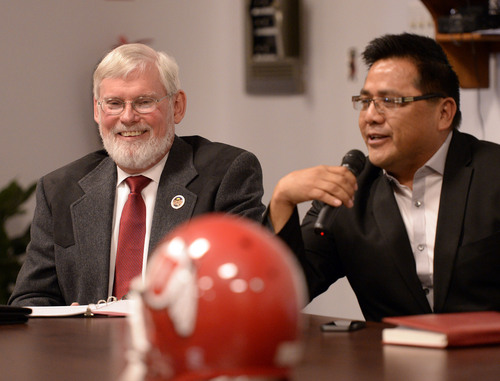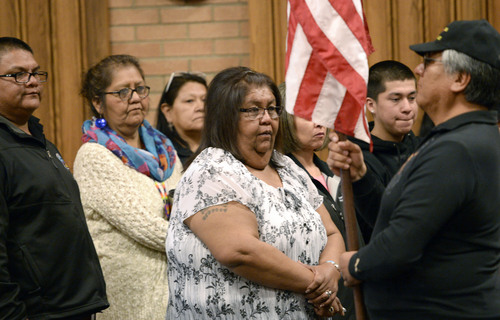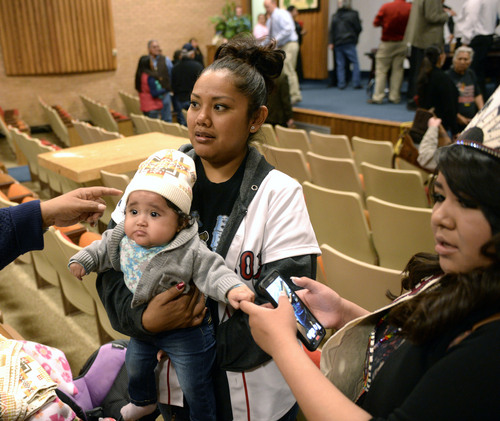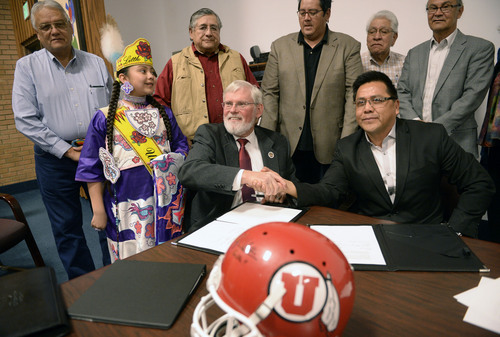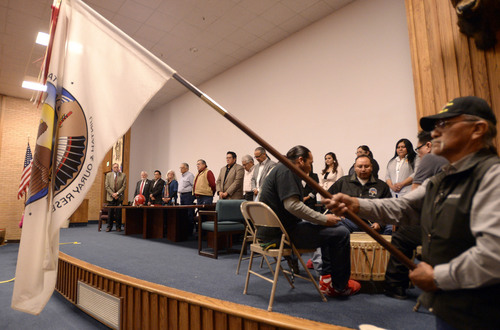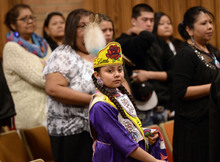This is an archived article that was published on sltrib.com in 2014, and information in the article may be outdated. It is provided only for personal research purposes and may not be reprinted.
Fort Duchesne • The University of Utah will continue to use the Ute name with the all-important support of Ute Indian Tribe leaders.
On Tuesday, the school agreed to a five-year agreement that centers on efforts to help reservation youths. The new memorandum of understanding was signed by U. President David Pershing and Ute Indian Tribe Business Committee chairman Gordon Howell shortly before noon Tuesday in Fort Duchesne.
The U. agreed to fund scholarships not only for American Indian students, but also specifically for Ute tribal members, and to promote education about the tribe's history. The U. will also donate proceeds from sales of a special football jersey worn during a home game in November (either for Oregon or Arizona) to a Boys & Girls Club the tribe plans to open.
"This isn't about money; we need to be clear about that," Pershing said. "This is about educational opportunity."
A previous memorandum of understanding, signed in 2005 in response to restrictions from the NCAA, was lighter on specifics and expired in 2009. Howell said nobody realized it had expired until last year, and Tuesday's announcement was the culmination of more than a handful of meetings between the two parties since the tribe began to renegotiate.
"We wanted to bring to their attention that our youth is very important to us," Howell said, "and that we would like them to attend the University of Utah or further their education no matter where it's going to be."
There are four Ute tribes, and according to the Utah Athletics website, the Utes name is most closely affiliated with the Northern Utes, who have a tribal membership of 3,157. But Howell said representatives from the Southern Utes and the Ute Mountain Utes attended meetings as well.
U. leaders stood Tuesday while the Red Spirit drum group opened the proceedings and a prayer was delivered by tribe elder Leo Tapoof — after a short speech that he ended with "Go Utes!"
The football jerseys are not yet designed, and the tribe will have its choice of a couple of options, Howell said. The business committee originally asked for a helmet with a war-bonnet design, but the U. leaders "felt like they didn't want to disrespect the tribe, which we understood."
Other aspects of the new MOU include:
• The tribe will appoint an unpaid adviser to Pershing who will serve as a liaison between the groups, and the U. will create a full-time Utah College of Applied Technology advising position to help reservation students apply for college.
• The Utah Tribal Leaders Council will appoint two members to the American Indian Resource Center's advisory board.
• Tribal youths will be able to attend U. sporting events and meet athletes who were able to earn scholarships despite having come from underprivileged backgrounds.
"It won't just be from year to year, it will help for decades," Howell said. "It's been a very important issue for our council, that we feel we're losing our youth."
The agreement comes amid objections from within the U.'s own ranks over the school's handling of diversity. Last week, assistant vice president for student equity and diversity Enrique Alemán resigned in part, he said, because he was accused of leaking the letter the U. received from the Ute Tribe.
Days earlier, chief diversity officer Octavio Villalpando resigned. Alemán said he was told Villalpando was being investigated for human resources issues.
A U. student group in December petitioned the school to drop ties with the tribe altogether, rather than continue to react to evolving notions of political correctness.
Even if handled delicately by the U., the teams' association with American Indians leads to a problem of "education," said Samantha Eldridge, a leader of the initiative and now a liaison for Native American Outreach in the National Education Association in Washington, D.C. Fans of the team must repeatedly be told it is inappropriate to wear mock headdresses or paint their faces red at games.
"We are always going to get a negative, stereotypical portrayal of Native Americans," Eldridge said Monday night. "We're always going to get a new cohort of students attending the university who we are going to continually have to educate on what is appropriate and inappropriate behavior."
Eldridge said the U.'s agreement with the tribe signals a step backward from a Pershing promise in September 2011 to phase out the drum-and-feather logo.
"For him to unilaterally change his mind," Eldridge said, "and underhandedly work with the Ute Tribe to negotiate a new memorandum is disappointing."
Pershing said she's right, that when he first became president, "I thought we might move further away from that," he said. "But this agreement is not about the drum and feather; this is about the name of the tribe, of our teams."
Howell said the school's use of the Ute name is very popular on the reservation. Children wear the Utah jerseys in youth football and seniors have U. license plates, he said.
American Indians are the U.'s smallest ethnic group. Just 171 of 31,520 U. students identified as American Indians in the 2012-13 school year.
More than 40 years ago, the U.'s athletics teams were often referred to using a slang for Native Americans that some consider derogatory. In one vulgar example, a 1963 football media guide cover depicts a horseback band of football players firing arrows at a traveling stage coach.
In 1972, the U. reached an agreement with the Ute Tribe to instead adopt the nickname "Runnin' Utes," but through the mid-1980s the U. continued to have a "Crimson Warrior" ride onto the field at football games and drive a spear into a hay bale.
In 2005, the NCAA attempted to restrict the U.'s use of the Utes nickname, but the school appealed on the grounds that the name was appropriate, given that it had a good relationship with the tribe. The NCAA agreed.
The U. has opted more frequently in recent years for the "Block U" symbol over the drum and feather — or as the university calls it, the "circle and feather."
View the MOU at admin.utah.edu/ute-mou.
Tribune reporter Lindsay Whitehurst contributed to this story.
Twitter: @Lya_Wodraska
Twitter: @matthew_piper


